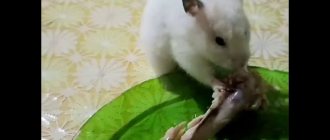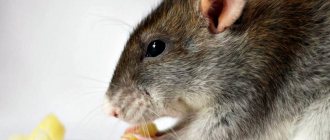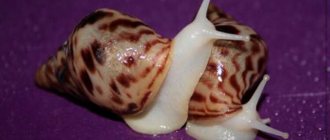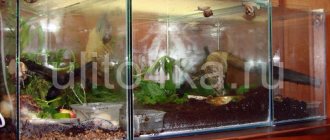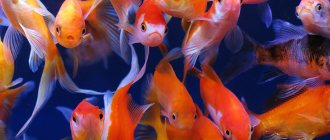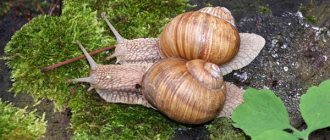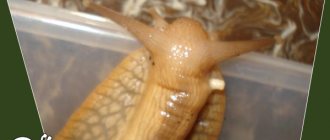Home » Useful Information
The African snail Achatina is an exotic pet. With proper care, the mollusk grows to enormous sizes. It is important for breeders to know what to feed Achatina at home in order to provide them with all the nutrients necessary for life and growth.
- 1.1 What can you feed Achatina
1.1.1 Video: greens in the diet of Achatina
- 1.1.2 Video: feeding Achatina, nutritional supplements
- 2 Achatina diet at home
- 3 Vitamins and minerals
- 4 Sources of calcium in the snail's diet
- 5 How often should you water shellfish?
- 6 What to feed newborns and small snails
6.1 Video: reproduction, laying, how to care for cubs
What do Achatina eat?
African snails in nature feed on leaves, shoots and fruits of various plants. Many species of these animals are pests in natural conditions. They can cause significant damage to crops by eating them. But in Europe and Russia, due to the climate, Achatina does not pose a threat to established ecosystems.
Achatina are vegetarians by nature. Despite the fact that their homeland is Africa, they enjoy our local vegetables and fruits, and the list of permitted products is huge. In a terrarium, they happily eat various local vegetables, fruits and herbs.
Many people include sweet fruits in snail food. In principle, shellfish can choose one product and eat it with pleasure, but still, variety should be added to their diet. It should include fiber, minerals (calcium) and proteins. Vitamin greens, dandelion leaves, etc. are especially useful. Let's find out more about this.
✅ Vegetables and fruits
Before offering vegetables and fruits to Achatina, they must be washed and cut into small pieces. Pumpkin, zucchini and other dense vegetables are grated for small snails. All products should be at room temperature.
Achatina loves the sweet pulp of bananas, but babies can’t have it. They bite into the flesh and then cannot get out of there. Snails quickly get used to bananas, and then they don’t want to eat anything else. Therefore, it is better to give bananas 1-2 times a week.
Avocados, peaches, cucumbers, non-acidic varieties of tomatoes are delicacies for Achatina. They eat these fruits with great pleasure.
Classic vegetables (carrots, beets, cabbage of all varieties, sweet peppers) can be given daily without restrictions.
You can also add any melons to your diet. Potassium, iron, vitamins, and fiber contained in watermelon will only be beneficial.
Attention ! It should be remembered that a high content of nitrates in products can lead to the death of the snail. Unscrupulous melon growers often use nitrates to speed up ripening. It is necessary to choose watermelons and other melons that have ripened naturally, without nitrate feeding.
Fruits that snails can eat:
- apricots;
- avocado;
- a pineapple;
- watermelon;
- bananas;
- cherry;
- pears;
- melon;
- zucchini;
- carrot;
- nectarine;
- cucumbers;
- squash;
- beet;
- Bell pepper;
- plums;
- tomatoes;
- pumpkin;
- persimmon;
- zucchini;
- apples.
✅ Greens and herbs
Snails adore any juicy table greens. This could be parsley, celery, dill, dandelions, nettles, plantain.
What greens can Achatina eat:
- White cabbage;
- Brussels sprouts;
- cauliflower;
- clover;
- nettle;
- plantain leaves;
- lettuce leaves;
- birch foliage;
- oak foliage;
- linden foliage;
- raspberry foliage;
- currant foliage;
- burdock;
- alfalfa;
- woodlice;
- dandelions;
- parsley;
- chamomile;
- celery;
- dill;
- spinach.
✅ Berries
⚫ Grapes
Snail breeders have been arguing about grapes for a long time. They came to the conclusion that it is possible to give grapes, but rarely, since Achatina quickly gets used to it and refuses other food. Grape leaves can be served fresh or dried. Grapes can be frozen for the winter and fed in small portions 1-2 times a week.
⚫ Strawberries and wild strawberries
Local species of snails adore strawberries and gobble them up in the garden beds without a twinge of conscience. This berry also attracts Achatina. You can prepare strawberries in the summer by freezing them and give them a little in the winter. Thawed berries retain all their beneficial qualities and will support shellfish during the long winter. They are rich in vitamins and minerals and have an antimicrobial effect.
⚫ Raspberry
Fresh green raspberry leaves are also beneficial for snails, as are the juicy, aromatic berries. They can be dried and used in the winter as top dressing. Fresh and defrosted berries can be safely placed in the feeder.
Berries that are allowed for Achatina:
- grape;
- strawberries;
- strawberry;
- raspberries.
✅ Dairy products
Milk is a valuable product that contains protein, calcium, and many useful microelements. Many snail breeders cannot agree on the benefits of milk for Achatina. Some say that there is no need to give dairy products to snails, because in their natural habitat they do not consume them. On the other hand, domestic Achatina are already accustomed to living with people and their diet may differ significantly from their wild relatives.
If you want to give milk to Achatina, then give low-fat milk (up to 2.5%), or even diluted milk. And then look at the pets’ reaction. In any case, it is not recommended to give dairy products daily.
Dairy
- low-fat sour cream;
- skimmed milk;
- skim cheese.
✅ Cereals, seeds and nuts
Cereals and nuts are usually given in mixtures in ground form.
Cereals
- buckwheat grain;
- corn;
- oats;
- millet;
- rice;
- rye;
- barley.
Seeds and nuts (raw)
- Walnut;
- pine nuts;
- cashew nuts;
- sesame;
- almond;
- flax seed;
- sunflower seed;
- pumpkin seeds;
- hazelnut.
✅ What else do snails eat?
Some Achatina are very fond of mushrooms. They can be consumed raw or dried. As a rule, these are champignons or oyster mushrooms. Mushrooms are often added to the protein mixture, and some snail breeders plant mushrooms directly in the soil where their pets live.
Many people notice that snails happily eat paper. This is natural, since paper is made from cellulose, and clean, unprinted paper will not harm domestic shellfish. Do not leave pieces of newspapers or printouts from under the printer in the container.
Fish food (daphnia) may also appeal to snails. It compensates for the lack of protein in the body.
Achatina eat with great pleasure dried fruits prepared at home (apples, pears, plums, etc.).
Other
- Mushrooms (edible)
- Fish food (daphnia);
- Dried fruits
- Blank paper.
Cucumber
Now let's figure out whether snails can eat cucumbers. This vegetable can also be present in the diet of domestic Achatina (another species), if there is complete confidence in its naturalness.
Fresh, nitrate-free cucumbers collected in summer are a good treat for shellfish. But the high content of harmful substances in these vegetables can result in the death of your pet.
Even if Achatina prefers cucumber and lettuce to other vegetables, you should not constantly feed it only this monotonous food. This leads to an imbalance in the body, which is often the cause of disease and developmental disorders. Instead of cucumbers, you can include zucchini, sweet peppers, and chopped fresh carrots in your clam’s diet.
What not to give to snails
Snails are strictly prohibited from consuming table salt and foods containing salt, citric or other acid, sugar and starch.
Akhatins are prohibited:
- legumes;
- fried vegetables;
- candied fruits;
- smoked products;
- pasta;
- semolina;
- salt and everything salty;
- spices;
- dried dried fruits (figs, raisins);
- raw potatoes.
Through trial and error, it was determined that Achatina should not be fed hot and spicy herbs (onions, garlic, mustard salad, hot red peppers) and citrus fruits.
Potato
A common question: can snails eat potatoes? Let’s look at them especially carefully.
This root vegetable is known for its high content of starch, the consumption of which is not typical for shellfish. Its presence is extremely undesirable in the diet of Achatina and other invertebrates. At the same time, some snail breeders still offer their pets mashed potatoes in small quantities.
Mineral nutrition for Achatina
It has been proven that calcium is the most important mineral supplement for Achatina. Without this mineral, Achatina will not be able to grow, its shell will collapse, and eventually the snail may stop growing and become ill. It is important both for small snails and for adult individuals, since Achatina grows throughout its life. If the snails begin to have problems with the shell (it cracks, flakes, etc.), you should urgently increase the size of the mineral supplements.
This can be a pure calcium mixture:
- feed chalk;
- crushed egg shells;
- sepia;
- shell rock, etc.
You can prepare a calcium-rich mix, which is seasoned with vegetables or given separately.
✅ Recipes for calcium-rich mixture
Option 1:
- 50 g oat flakes;
- 50 g rice;
- shells of 5–6 eggs;
- 20 g chalk;
- 20 g shell rock.
Option 2:
- 50 g buckwheat;
- 100 g chalk;
- 20 g dried mushrooms;
- shells from 5 eggs;
- sepia for snails (cuttlefish shell ground into powder) - 1 pc.;
- 1 tbsp. l. bone meal;
- 20-30 g sesame seeds.
Mix all ingredients and grind to form ground coffee. Store in a closed jar in a dry, dark place. Shellfish eat this mixture with great pleasure. You can also prepare a pure grain mixture from various grains.
✅ Protein feeding
Protein is essential for any living creature, and Achatina is no exception. Plant and animal proteins are the “building blocks” in the construction of body cells. For snails, you can prepare ground products containing vegetable protein:
- cereals;
- corn;
- bran;
- Champignon mushrooms);
- nuts;
- seeds.
Animal proteins can be useful for snails in the form of dried milk, dried daphnia, and bone meal. But you should be careful with this type of feeding. Overeating protein threatens Achatina with poisoning and death. You can give protein to snails no more than 2 times a week.
Feeding mode
Breeders believe that if we are talking about the growing body of a young Achatina, then it needs to be fed daily. And the hatched little snails are even fed several times a day so that they do not lag behind in development. Adult snails can go without food for two to three days. It is believed that Achatina herself will let you know when she is full. Here are just a few signs when you need to stop feeding your pet:
- refusal of food;
- sluggish and reluctant eating;
- a large amount of food remains on the plate.
Domestic snails Achatina, like mammals, have food preferences. Some owners have noticed more than once how the snail refused, for example, cabbage in favor of a cucumber or banana. Taste habits can change with age. Young snails love living vegetation, while adults love rotting roots.
Conclusion: you need to feed your domestic Achatina with a variety of foods, but not spoil the animal.
How to feed snails in winter
In summer there are plenty of fresh vegetables and fruits, but what to feed Achatina in winter? Top dressing can be prepared in advance and stored in a jar in a dry place. In winter, in any store you can buy pumpkin, carrots, apples, cottage cheese, sour cream, cabbage, etc. for snails. Vegetables (zucchini, tomatoes, etc.), herbs and fruits can be frozen.
A great idea would be to grow herbs and lettuce on the windowsill. You can also germinate various seeds and even mushrooms in the soil of the terrarium. Sprouted wheat or oats will be an excellent food for Achatina. You should not buy out-of-season vegetables and fruits at the store. They are grown using large amounts of fertilizers. By overeating nitrates, the snail can become poisoned and die.
Basic moments
A variety of vegetable crops must be included in the diet of a domestic snail. This is especially important in winter, when there is not enough fresh, juicy greenery.
Before you find out what vegetables Achatina snails eat, it is advisable to learn the main rule: all products of plant origin that your pet will eat must be grown on your own plot. If you buy them in a supermarket in winter, there is a danger of poisoning the snail with various chemicals contained in such products.
Read on to find out whether snails eat melon, cucumbers, watermelon, tomatoes, eggplants, carrots, and what other vegetables can be given to snails.
Forbidden wild herbs
These include all herbs that are poisonous to humans, as well as some medicinal and aromatic herbs. There is a high probability that the snail will refuse such herbs on its own, but experiments are useless.
For example,
- sagebrush
- hogweed
- ambrosia
- flowers of wild plants
- oregano
- St. John's wort
- thyme
- yarrow
Some aromatic herbs are not poisonous and will not cause harm, but they also have little benefit. In nature, snails prefer neutral and tender juicy herbs.
The main rule is that if in doubt, give up the idea of feeding the snail with new interesting food. Believe me, the variety that can be found among the proven options is quite enough to make the snail happy, and you, as the owner, do not worry about its health and satisfaction with the food variety. By the way, in addition to herbs, there are also berries, fruits and vegetables.
Cabbage
Is it possible to give Achatina snails cabbage (Peking cabbage, cauliflower)? This vegetable (all varieties) is universal for feeding most types of gastropods.
Cabbage leaves are even used as soil for newborn snails, and as a kind of “plate” for grain cereals and nutritional mixtures.
Young cabbage leaves are more tender than those that have been stored throughout the winter. The taste of the latter is much sharper, so it often does not arouse interest among mollusks.
This vegetable in any form (raw, boiled, steamed) can be present “on the table” of a domestic snail. Cauliflower is very useful, as it contains everything that is necessary for normal growth and development (fiber, iron, calcium, sulfur, fluorine, phosphorus, etc.).
Carrots and beets
Let's consider the question: can Achatina snails eat carrots or beets?
As for carrots, fresh (or boiled) they can serve as food for Achatina, starting from their birth. It is enough to chop the vegetable with a grater and offer it to the snails.
Carrots contain a lot of beta-carotene, as well as vitamins B, C, E, K, PP. In addition, this vegetable contains a lot of iron, calcium, fluoride, zinc and 1.3% protein.
It is better to give beets to snails in boiled form, but first crush them using a grater.
In addition to root vegetables, tops are also suitable for food. It can serve as a bedding and a “vitamin plate” for babies.
Prohibited cultivated herbs
As I already said, these include all those that have a pronounced peppery, garlic, mustard taste or any other strong aroma:
- watercress – has a mustard flavor
- wild garlic leaves – spicy taste
- arugula – has a mustard flavor
- rhubarb – tart taste
- Sorrel is sour and also blocks the absorption of calcium.
- green onions - spicy
- garlic leaves – contain many essential oils
- Potato tops – may be poisonous as they contain solanine
- tomato tops – very aromatic, poisonous to snails
- horseradish leaves – spicy, pungent
- Radish leaves are sometimes bitter, so it’s better not to risk it.
